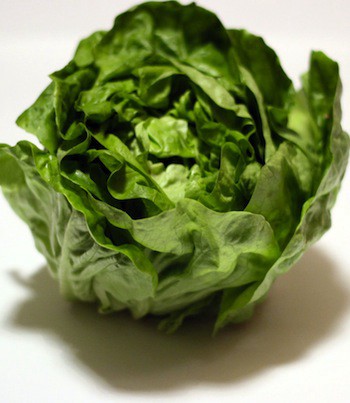The Best-Dressed Salads
by Alyssa Bereznak

1. Arugula
Big Break: Arugula’s make-or-break moment came in 2006, when a deadly spinach e coli outbreak caused the nation to look elsewhere for dainty greens. Since then, it’s had a few ups and downs, returning on our radar in 2007, when Obama remarked on its pricey Whole Foods gig. In a recent comeback, the bitter leaf has slipped into stunning dressing after dressing on the covers of Bon Appetit and Good Housekeeping. Signature Dressing: The self-proclaimed “salad rocket” opts for mustard-hued vinaigrettes, statement-making sunflower seeds, and the occasional daring grape. Favorite feature: Its unusual silhouette. Style Icon: Ramps.
2. Frisée
Big Break: Previously known as endive’s eccentric cousin, Frisée made its debut in the 1978 eponymous indie French film La Frisee aux Lardons. A fruitful and well-dressed career followed. Signature Dressing: The Daisy-family darling cloaks itself in red-wine vinegars, maximalist poached eggs, and shimmering shallots. It’s often seen cavorting with the lardon social set. Favorite Feature: Its whimsical draping. Style Icon: Parsley.
3. Kale
Big Break: Long typecast exclusively as a decorative outdoor plant, Kale stole the show when it shot to the top five of Whole Foods’ Aggregate Nutrient Density Index, the Oscars of nutrition. Signature Dressing: The controversial winter-loving borecole favors deep purples, structured seasonings, creamy sheaths, and candied walnuts. Favorite Feature: It’s resilient skin. Style Icon: Brussels sprouts.
4. Spinach
Big Break: Spinach has been shoveled into American mouths since it scored a spot as Popeye the Sailor Man’s nutrient-rich sidekick in the 1920s. Known in some circles as the Cary Grant of the Amaranthaceae, the towering plant has enjoyed a comfortable standing in plant culture, despite the occasional defamatory New Yorker cartoon. Signature Dressing: Prideful of its manicured membranes, the oval icon opts for barely-there Dijons, audacious bacon accessories, and sultry strawberry chapeaux. Favorite Feature: Its towering height. Style Icon: Basil.
5. Lettuce
Big Break: Strongly rooted in American history, lettuce was hand-picked to accompany Christopher Columbus on his 15th-century ocean voyage. Its subsequent career brought many a nickname and variety. Though some have pegged this headstrong plantae as one-note, lettuce’s near ubiquitous presence in pop culture is undeniable. Signature Dressing: The celebrated Asteracae often tips a crouton to its Roman heritage, donning creamy Caesar shifts, parmesan-flake fascinators, and tomatoes ripe for the red carpet. Favorite Feature: Its funky purple leaves. Style Icon: Rose hips.
6. Mesclun
Big Break: Famous for blending different genre leaves seamlessly, this French-Italian mixture first gained U.S. notoriety when Alice Waters championed its taste at Chez Panisse. After an unfortunate commercial streak with major labels such as Dole in the 90s, the salad laid low, winning back public favor via indie farm-based distributors. Signature Dressing: The complex mix masks itself in fruit-based frocks, peplum pancettas, and goat-cheese pom-poms. Favorite Feature: Its uniqueness. Style Icon: Rosemary.
7. Radicchio
Big Break: This perennial chicory was first called a “hip designer lettuce” by the Philadelphia Enquirer in 1993. Its subsequent years saw increasing success, inspiring the name of at least one Manhattan establishment and accolades from the likes of Bon Appetit and Martha Stewart. Signature Dressing: Always freshly bronzed from the grill, the spicy leaf gravitates toward sherry-based sachets and rustic parmesan wraps. Favorite Feature: Its fierce stems. Style Icon: Baby beet greens.
8. Endive
Big Break: A host to many main players in the seafood set since the days of Titanic, the Belgian endive has enjoyed a long legacy as an hor d’oeuvres stunner. The Belgian Endive Marketing Board has gone so far as to deem the salad “white gold.” Signature Dressing: The chicory maintains sleek lines, often donning just one glorious statement piece — for instance, its trademark goat-cheese coat and dill fascinator — atop its silky surface. Favorite Feature: Its curve. Style Icon: The artichoke.
9. Watercress
Big Break: As one of the oldest known leaves to be consumed by humans, Watercress has spent most of its modern career as an unrecognized garnish. However, in recent years this bubbly Brassicaceae has steadily gained indie cred among foraging circles in Brooklyn. Signature Dressing: Watercress wows with sleek avocado accessories, white-wine wraps, and fresh citrus separates. Favorite Feature: Its full-bodied leaves. Style Icon: Mustard.
10. Tatsoi
Big Break: Though still little-known to mass markets, tatsoi makes our top-ten as a salad to watch. Lovingly nicknamed “spoon mustard,” the Japanese plant has earned a grassroots following, blowing up the CSA-blogosphere and slowly creeping into the mainstream media. Rumor has it the Brassica narinosa can even be harvested from beneath snow. Signature Dressing: An experimental salad, tatsoi opts to be completely nude, or found limp and unmanicured in a ball gown of soup. Favorite Feature: Its ability to really feel the water on its leaves. Style Icon: Burdock.
Alyssa Bereznak is an Editorial Associate at Vanity Fair and lives in Brooklyn, where she resides with a half-dead rosemary plant. Follow her on Twitter @alyssabereznak.